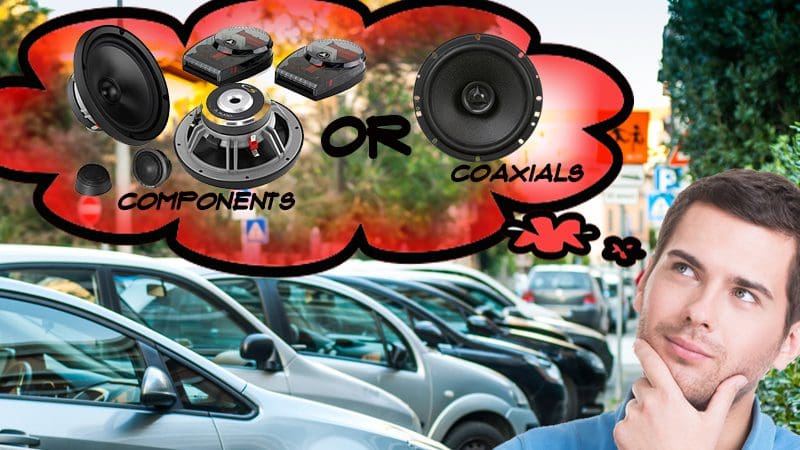 Developing a speaker requires that the designer and engineer balance many different aspects, such as the application, cost and desired performance level of the end product. For the consumer, navigating the thousands of different speaker offerings on the market can be difficult. Two speakers can measure similarly regarding efficiency, power handling and frequency response, but still perform completely differently because of different distortion characteristics. Cone, dust cap and suspension resonance, motor non-linearity, and enclosure/application requirements play a crucial role in determining how the end-product will sound once installed in the listening environment. This article scratches the surface of looking at the benefits and drawbacks of choosing speakers by comparing coaxial and component speaker designs.
Developing a speaker requires that the designer and engineer balance many different aspects, such as the application, cost and desired performance level of the end product. For the consumer, navigating the thousands of different speaker offerings on the market can be difficult. Two speakers can measure similarly regarding efficiency, power handling and frequency response, but still perform completely differently because of different distortion characteristics. Cone, dust cap and suspension resonance, motor non-linearity, and enclosure/application requirements play a crucial role in determining how the end-product will sound once installed in the listening environment. This article scratches the surface of looking at the benefits and drawbacks of choosing speakers by comparing coaxial and component speaker designs.
When Choosing Speakers, Define the Design
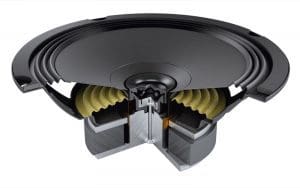 Component (or separate) speakers are a set of speakers that includes a set of dedicated midrange drivers and dedicated tweeters. Each of those four speakers requires a dedicated mounting location. By contrast, a coaxial speaker features a midrange driver with a tweeter mounted in the center of it. In most cases, the tweeter is on top of an extension post connected to the pole piece. Other coaxial designs use a bridge or mesh grille to suspend the tweeter over the midrange. These are sometimes called coaxially mounted components by marketing departments.
Component (or separate) speakers are a set of speakers that includes a set of dedicated midrange drivers and dedicated tweeters. Each of those four speakers requires a dedicated mounting location. By contrast, a coaxial speaker features a midrange driver with a tweeter mounted in the center of it. In most cases, the tweeter is on top of an extension post connected to the pole piece. Other coaxial designs use a bridge or mesh grille to suspend the tweeter over the midrange. These are sometimes called coaxially mounted components by marketing departments.
Benefits of Coaxial Speakers
In most cases, coaxial speakers are the less-expensive options in a product lineup. This pricing is due to the chosen target customer and not because you can’t make a high-quality coaxial speaker. Less-expensive magnets, baskets, cone materials and suspension components, and wider tolerances that allow for faster production with fewer rejected assemblies, all help reduce cost. The benefit is, if you need an inexpensive speaker, coaxials are a good solution.
Coaxial speakers can be installed faster, so they are less expensive to install. The integrated tweeter saves a lot of time during the installation process. Most coaxial speakers have integrated crossovers of some sort that don’t require special wiring or mounting. The net result is that your installer can get them up and running in your vehicle in about half the time it takes to install a component set, which means your labor charges will be reduced.
Benefits of Component Speakers
Most component speakers are made from better materials and have higher performance goals. High-end components can cost more than $5,000 for a set and often include premium passive crossover networks, elaborate installation accessories and – of course – amazing speakers. The sound that component speakers produce, when installed and tuned properly, can be amazing!
When a good set of components is tuned properly, most of the sound can appear to come from the tweeters. Having a separate tweeter allows your installer to mount it high in the vehicle – at the top of the door, on the dash or in the A-pillar. The combination of proper tuning and placement puts the music out in front of you, essentially at eye level. This higher soundstage is similar to what you would experience at a concert, listening to the band performing in front of you.
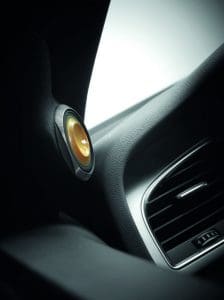 Many factors contribute to where and how your installer mounts the tweeters – your budget, your performance goals, and how much modification you want or will allow to your vehicle. All locations have their benefits and drawbacks. For example, a tweeter mounted on the dash or A-pillar is very near the windshield. The hard surface of the windshield can cause significant reflections. Alternatively, a mounting location in the upper section of the door may reduce these reflections, but may not raise the soundstage as high, or could make it appear to come from somewhere closer to you than the dash or pillar location.
Many factors contribute to where and how your installer mounts the tweeters – your budget, your performance goals, and how much modification you want or will allow to your vehicle. All locations have their benefits and drawbacks. For example, a tweeter mounted on the dash or A-pillar is very near the windshield. The hard surface of the windshield can cause significant reflections. Alternatively, a mounting location in the upper section of the door may reduce these reflections, but may not raise the soundstage as high, or could make it appear to come from somewhere closer to you than the dash or pillar location.
A component speaker doesn’t have any of its output blocked by the tweeter, which eliminates some minor reflections . Likewise, with a coaxial speaker that uses a tweeter post, a component speaker can have a full dust cap. The dust cap moves with the cone and increases the driver cone area. Additional cone area increases the driver’s efficiency.
The Huge Role of Crossovers
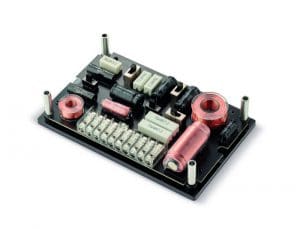 Whether you choose a coaxial or component speaker set, you are going to need a crossover to handle splitting up the frequencies. In the most basic of speakers, a capacitor is used on the wire going to the tweeter to block low and midrange information. The midrange driver is allowed to roll off naturally – ideally, there are no significant high frequencies resonances that will affect the sound.
Whether you choose a coaxial or component speaker set, you are going to need a crossover to handle splitting up the frequencies. In the most basic of speakers, a capacitor is used on the wire going to the tweeter to block low and midrange information. The midrange driver is allowed to roll off naturally – ideally, there are no significant high frequencies resonances that will affect the sound.
As you progress up through the quality of a speaker set, you will see steeper filter networks on tweeters. These steeper networks allow the tweeter to play to a lower frequency and then be stopped to protect it from excursion damage. At the same time, filtering the high-frequency output of the midrange is common in mid- to high-end crossover networks. Speaker manufacturers construct the most elaborate of crossover networks with premium components for both the high- and low-pass portions of the network. Adjustability is often built into the crossover for tweeter level. Small components can be overdriven and saturated, reducing their effectiveness. Large amounts of distortion can cause the tweeter cap to overload and explode.
The Option of Coincident-mounted Coaxial Speakers
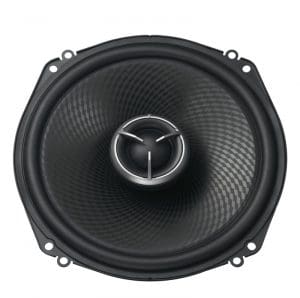 The radiation pattern of a speaker is a sphere in its standard operating range. As frequency increases, this output pattern becomes more directional. When a tweeter is mounted at the base of a midrange, a phenomenon occurs called Intermodulation Distortion. As the cone of the midrange moves up and down to reproduce music, this moving surface modulates the reflections of the tweeter.
The radiation pattern of a speaker is a sphere in its standard operating range. As frequency increases, this output pattern becomes more directional. When a tweeter is mounted at the base of a midrange, a phenomenon occurs called Intermodulation Distortion. As the cone of the midrange moves up and down to reproduce music, this moving surface modulates the reflections of the tweeter.
It is worth noting that the same thing happens when a single speaker cone is asked to reproduce high frequencies: The source of the high-frequency sounds moves forward and rearward as the speaker cone attempts to reproduce lower frequencies. This modulating effect is known as Doppler Distortion. These distortions, combined with the narrowing of the radiation pattern as frequency increases, are some of the many reasons why we have to use different-sized speakers to reproduce music accurately.
When shopping for a coaxial speaker, you will want to choose one that has the tweeter mounted low enough not to interfere with the installation of a grille or trim panel over top of the speaker. You should also look for a tweeter that has a small waveguide that prevents the output from bouncing off the midrange cone.
Shopping for Speakers
We could spend years discussing the different aspects of speaker design and performance. Suffice it to say that you should seek out the assistance of a seasoned and reputable professional for purchase and installation. Be sure to quantify as much of the purchase process as possible – your financial limits, cosmetic preferences regarding installation and performance goals for the system. You will want to use music you have listened to many times when auditioning speakers.
You may want to listen to both a set of more- and less-expensive speakers to help quantify the price point you have chosen. Finally, talk with the salesperson and, if possible, the installer about how and where the speakers will be installed. Be sure to ask about sound deadening, spacers, wiring and anything else that can affect the performance of the installed speaker.
Speaker shopping is a lot of fun, and getting new speakers for your car, truck, boat or motorcycle can be very exciting. Be patient – take your time and be thorough. You will enjoy your new purchase all that much more when you choose a great-sounding speaker and a skilled installer.

Which car stereo brand has best sound quality?